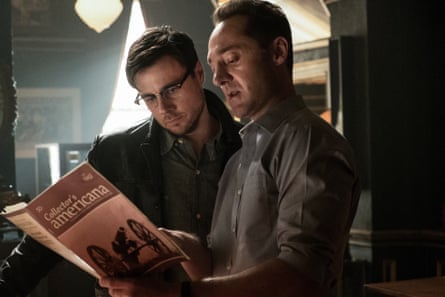Warning: contains spoilers.
The increasing occurrence of Difficult Second Season Syndrome – with True Detective and Broadchurch major offenders and Transparent a minor one – means that our pleasure at the return of a recent success is always shadowed with worry.
A particular fear in the case of The Man in the High Castle, which streams its second run on Amazon from today, is that this drama is a prime example of a TV show that, in the past, would have been shot as a whole in one.
The main business of the 1963 Philip K Dick source novel – imagining a world in which Germany and Japan won the second world war and divided the coasts of the US between them – was dealt with in the 10 episodes released in 2015.
The dizzying visual shocks of the reversed world – such as seeing the eagle of the Third Reich atop New York skyscrapers – can merely be repeated in the second series, with further examples of how Hitler’s empire-builder, Albert Speer, might have retooled the US and Japan. Although there are still tremendous chills in the details of the alternative reality – such as the American schoolchild reciting the morning “pledge of allegiance” to the Nazis in the first of the new episodes – the basic shapes of the alternative 20th century are now familiar.

Ominously, disagreements about where the show should go next were the reason given by series creator Frank Spotnitz for his unexpected departure from the franchise. Certainly, 10 hours would have been enough to satisfyingly conclude the storylines of the main figures: Juliana (Alexa Davalos), a San Franciscan woman entrusted by her now-dead sister with footage depicting a world that we recognise but the characters don’t; Joe (Luke Kleintank), a double-agent posing as a member of the American Resistance; Gruppenführer John Smith (Rufus Sewell), a US Nazi officer; and Tagomi (Cary-Hiroyuki Tagawa), a Japanese official who experiences visions he interprets as nightmares or prophecies but which we have seen in documentaries such as The World at War.
The first episode of season two sometimes feels slow, especially in the Tagomi strands. But it recovers by perfectly executing two moves from the playbook of TV long-runners: Complicating the Situation (the Japanese start plotting to nuke New York) and, crucially, Introducing a New Character: Stephen Root portrays the title figure, the obsessive and mysterious Abendsen, a sort of parallel-archivist who collects the films of events that have happened to us but not to them.
One reason for the present appeal of alternate reality stories – including the Stephen King-derived JFK drama 11.22.63 – must be that we live in a time when real-life storylines considered fanciful, such as the Trump presidency and Brexit, have become reality, turning on its head what seemed to be the historical narrative. With its first season screened in the late Obama period and the second going out post-election but pre-Trump, The Man in the High Castle straddles a cusp of uncertainty.
Drawing direct parallels with current events, though, is thwarted by the complex politics on show here. If a leftwing viewer might see it as a prophecy of the US’s susceptibility to fascism, supporters of Trump’s protectionist economics might draw a lesson of US vulnerability to Japanese imperialism. There must be a particular poignancy for actors of Asian heritage in the cast, who are granted unusually large screen-time but in return for playing second world war-era Japanese stereotypes. Similarly, Brexiteers might be reminded of Germany’s dark past, while Remainers could, as the German-Japanese axis conquered an isolationist US, spot a moral of the importance of international alliances to national defence.

An area that might be expanded is the nature of popular culture in Nazi-run America. The rise of alt-reality fiction is influenced – and even scientifically justified – by the work of Professor Stephen Hawking, whose “multiverse” theory, which suggests there may be numerous different versions of our world, uses examples from mass entertainment. Hawking recently consoled teen pop fans with: “It would not be beyond the realms of possibility that somewhere outside of our own universe lies another different universe. And in that universe, Zayn is still in One Direction.”
The haunting German-inflected recording by Jeanette Olsson of the song Edelweiss that is the theme tune to The Man in the High Castle plausibly indicates that there may have been a Third Reich influence on the Billboard charts in this other US. However, the soundtrack also includes hits from the American 60s we know, including Neil Sedaka’s Calendar Girl and Paul Anka’s My Home Town, although Sedaka’s Jewish background would surely have troubled the Nazi minister for popular enlightenment and propaganda – and Anka’s Greek Orthodox roots might inflame Hitlerite purists as well.
Using familiar tunes could be seen as an ironic commentary from our world on the one we are watching: the home town invoked by Anka now includes brown-shirted students getting off a yellow school bus with the Third Reich eagle on its fender. But US popular culture would likely have been very different if the ideas of Goebbels had prevailed. What, for example, might the Nazis in TMITHC make of the Beatles, who are due, at least by our timetable, to reach the US soon?

Comments (…)
Sign in or create your Guardian account to join the discussion